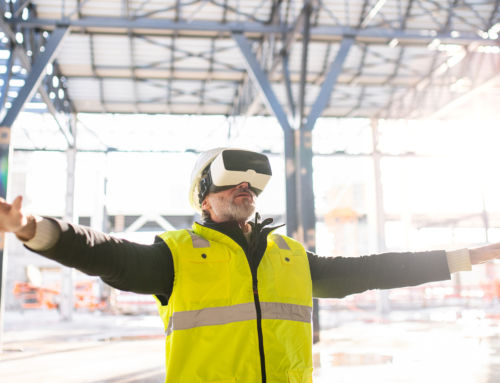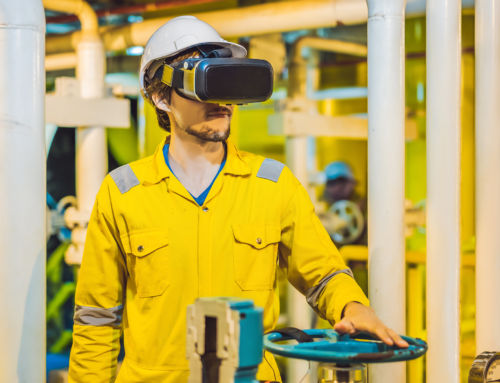Whether operating off ladders or navigating fragile roof surfaces, working at height remains one of the biggest causes of fatalities and major injuries in the UK.
If you are an employer or you control work at height for a project, it’s up to you to check your staff have the right skills, competency and experience to perform tasks safely with access to relevant training.
In previous years, learning to work at height typically included classroom-based theory followed by on-the-job training. But as you’ll know, learning the ropes in situ comes with its risks – especially for those new and inexperienced to the role.
So, to give employees a risk-free space to gain experience and develop their skills, over 40% of small and medium-sized businesses across the UK now offer virtual reality (VR) training.
And today, we’re going to tell you why.
Who needs working at height training?
Anyone likely to work at height or supervise working at height. To give you a clearer idea of what ‘working at height’ means, the Health and Safety Executive (HSE) says you are working at height if you:
- work above ground/floor level
- could fall from an edge, through an opening or fragile surface
- could fall from ground level into an opening in a floor or a hole in the ground
Typical roles that require working at height include:
Scaffolders
Whether it’s a residential or commercial property, scaffolders are required to work at height on a daily basis. All workers must be able to erect, dismantle and alter scaffolding in a safe manner by following National Access and Scaffolding Confederation (NASC) guidance.
Telecommunications
Though part of a telecom technician’s role will be computer based, they’re also required to ascend and descend communication towers that can exceed heights of a hundred feet. A head for heights is vital!
Electricians
Depending on the specialism, some electricians are required to work on aeroplanes, mobile phone platforms and data cable lines. Some tasks require working off ladders or temporary towers, which requires necessary safety training.
Construction operative
With a range of tasks performed at height on a construction site, it’s no wonder falling is the biggest cause of major injuries and fatalities. For operatives to stay safe on-site, they must complete a working at height awareness course, at a minimum.
Commercial window cleaner
Operating on a small platform hundreds of feet from the ground, commercial window cleaners are exposed to dizzy heights daily. Both IPAF Mobile Elevated Platform and working-from-height training is an absolute must for all operatives.
Training challenges when working at height
Those working at height or supervising working at height are bound by law to provide necessary training under the 2005 Working for Heights Act.
Not providing the proper training or equipment to your workforce can lead to severe injury or even fatality. In 2021 alone, 35 deaths were caused by falling from height – more than any other cause in the workplace.
But training employees to work at height comes with challenges that go beyond the standard delivery you’d expect in a classroom-based environment – and here are the main culprits.
Lack of experience
It’s unlikely employees learning to work at height will have any previous experience. And though a qualified supervisor or designated trainer should accompany their training, risk of injury or fatality is still a possibility.
Exposure to risks
Although learning to work at height in situ provides invaluable experience, it also opens the door to risks and hazards. Where some training exercises might be more forgiving, making a mistake at height could lead to serious personal harm.
Support from mentors
In confined spaces, such as a commercial window-cleaning carriage, there’s little room to operate. For a trainer, this can be time consuming as it’s impossible to deliver practical training to a large group all at once. It can also increase training costs for employers.
Why VR is ideal for working-at-height training
It goes without saying working at height comes with many risks and hazards. Even during the practical training process where learners are accompanied by professionals, there’s still an element of danger.
But by incorporating VR into working-from-height training, workers can safely experience the risks attached to their roles long before they are physically assigned to work at height.
Not only does it offer staff more exposure to the demands of their role, but it also provides a platform where participants can replicate tasks and develop a deeper understanding – all in a risk-free environment.
What’s more, by learning in a life-like virtual environment with unlimited space, businesses can mentor and support multiple workers all at one time which saves considerable time and money on training costs.
According to a 2019 report released by PwC, it’s also been proven that VR cuts training time by up to 40%, with employee performance improving by up to 70%.
It’s because of these benefits that many working-at-height sectors – including the wind turbine industry – have made the leap from traditional training methods to their more advanced technological counterparts.
If you’d like to learn more about how to work at height safely using VR training, feel free to get in touch to book a demo.
Whether operating off ladders or navigating fragile roof surfaces, working at height remains one of the biggest causes of fatalities and major injuries in the UK.
If you are an employer or you control work at height for a project, it’s up to you to check your staff have the right skills, competency and experience to perform tasks safely with access to relevant training.
In previous years, learning to work at height typically included classroom-based theory followed by on-the-job training. But as you’ll know, learning the ropes in situ comes with its risks – especially for those new and inexperienced to the role.
So, to give employees a risk-free space to gain experience and develop their skills, over 40% of small and medium-sized businesses across the UK now offer virtual reality (VR) training.
And today, we’re going to tell you why.
Who needs working at height training?
Anyone likely to work at height or supervise working at height. To give you a clearer idea of what ‘working at height’ means, the Health and Safety Executive (HSE) says you are working at height if you:
- work above ground/floor level
- could fall from an edge, through an opening or fragile surface
- could fall from ground level into an opening in a floor or a hole in the ground
Typical roles that require working at height include:
Scaffolders
Whether it’s a residential or commercial property, scaffolders are required to work at height on a daily basis. All workers must be able to erect, dismantle and alter scaffolding in a safe manner by following National Access and Scaffolding Confederation (NASC) guidance.
Telecommunications
Though part of a telecom technician’s role will be computer based, they’re also required to ascend and descend communication towers that can exceed heights of a hundred feet. A head for heights is vital!
Electricians
Depending on the specialism, some electricians are required to work on aeroplanes, mobile phone platforms and data cable lines. Some tasks require working off ladders or temporary towers, which requires necessary safety training.
Construction operative
With a range of tasks performed at height on a construction site, it’s no wonder falling is the biggest cause of major injuries and fatalities. For operatives to stay safe on-site, they must complete a working at height awareness course, at a minimum.
Commercial window cleaner
Operating on a small platform hundreds of feet from the ground, commercial window cleaners are exposed to dizzy heights daily. Both IPAF Mobile Elevated Platform and working-from-height training is an absolute must for all operatives.
Training challenges when working at height
Those working at height or supervising working at height are bound by law to provide necessary training under the 2005 Working for Heights Act.
Not providing the proper training or equipment to your workforce can lead to severe injury or even fatality. In 2021 alone, 35 deaths were caused by falling from height – more than any other cause in the workplace.
But training employees to work at height comes with challenges that go beyond the standard delivery you’d expect in a classroom-based environment – and here are the main culprits.
Lack of experience
It’s unlikely employees learning to work at height will have any previous experience. And though a qualified supervisor or designated trainer should accompany their training, risk of injury or fatality is still a possibility.
Exposure to risks
Although learning to work at height in situ provides invaluable experience, it also opens the door to risks and hazards. Where some training exercises might be more forgiving, making a mistake at height could lead to serious personal harm.
Support from mentors
In confined spaces, such as a commercial window-cleaning carriage, there’s little room to operate. For a trainer, this can be time consuming as it’s impossible to deliver practical training to a large group all at once. It can also increase training costs for employers.
Why VR is ideal for working-at-height training
It goes without saying working at height comes with many risks and hazards. Even during the practical training process where learners are accompanied by professionals, there’s still an element of danger.
But by incorporating VR into working-from-height training, workers can safely experience the risks attached to their roles long before they are physically assigned to work at height.
Not only does it offer staff more exposure to the demands of their role, but it also provides a platform where participants can replicate tasks and develop a deeper understanding – all in a risk-free environment.
What’s more, by learning in a life-like virtual environment with unlimited space, businesses can mentor and support multiple workers all at one time which saves considerable time and money on training costs.
According to a 2019 report released by PwC, it’s also been proven that VR cuts training time by up to 40%, with employee performance improving by up to 70%.
It’s because of these benefits that many working-at-height sectors – including the wind turbine industry – have made the leap from traditional training methods to their more advanced technological counterparts.
If you’d like to learn more about how to work at height safely using VR training, feel free to get in touch to book a demo.































